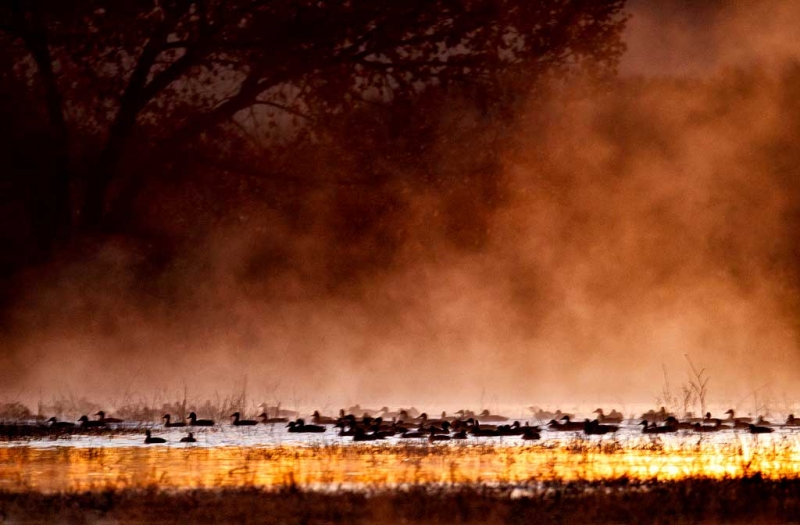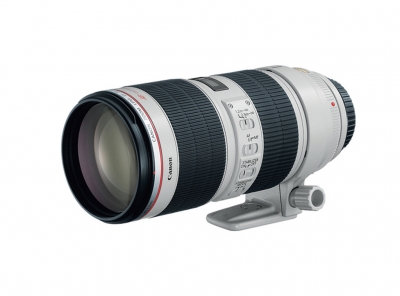|
Predawn ducks in the mist, Bosque del Apache NWR, San Antonio, NM. NOV 30, 2011. With the the tripod-mounted Canon 800mm f/5.6L IS lens and the EOS-1D Mark IV. ISO 4000. Evaluative metering +1 1/3 stops: 1/6 sec. at f/5.6 in Tv mode. Central Sensor Rear Focus/AI Servo AF and recompose. Click here if you missed the Rear Focus Tutorial. Lens/TC/camera body Micro-adjustment: +2. For a greater appreciation of the image, click on the photo. Then click on the enlarged version to close it. |
ISO 4000 at 1/6th of a Second…
Folks often ask, “What is the highest ISO that you will use?” I always answer: “I have no set limit: I will use what I need to get the image. The image above was created at 6:20 am about 45 minutes before the sun would peek over the distant mountains to the east. I figured that at 1/6 sec. I had a chance of getting the ducks sharp enough so that the image would work. And at ISO 4000 the image would show a bit of a grainy look that would add some character the way that film grain did.
Does this image work for you? What do you like about it? Why don’t you like? What is the highest ISO that you normally use? Do you go higher on occasion? If yes, then why?
When I am presented with some fire in the mist, even just a bit as here, I will always go for the gusto whatever it takes…
artie is gone 🙂
artie is traveling in the Southern Ocean (Falklands, South Georgia, & Antarctica) and will unable to respond to your questions and comments until after his return on 26 January 2012.
|
The Canon 70-200mm f/2.8L IS II is my very favorite intermediate telephoto zoom lens. I use it often with both the 1.4 and 2X III teleconverters. It will be on my shoulder via the Black Rapid RS-7 Strap for pretty much all of my Southern Oceans trip. |
B&H Killer Special
You can save $400 on one of my two favorite lenses from now through January 7, 2012 by clicking here. You can learn lots more about this great lens in dozens of blog posts especially here.. And you can save $400.00 off the regular price of $2374.00. It can be yours for only $1974.00 from now until 12/31/2011. (I learned today, 12/30/2011, that this deal will be good only through tomorrow and not through 7 January as I was originally told by my B&H contact. I apologize for any inconvenience.
Shopper’s Guide
Below is a list of the gear used to create the image above. Thanks a stack to all who have used the Shopper’s Guide links to purchase their gear as a thank you for all the free information that we bring you on the Blog and in the Bulletins. Before you purchase anything be sure to check out the advice in our Shopper’s Guide.
Canon 800mm f/5.L IS lens. Right now this is my all time favorite super-telephoto lens.
Canon EOS-1D Mark IV professional digital camera body. My two Mark IVs are my workhorse digital camera bodies.
And from the BAA On-line Store:
LensCoats. I have a LensCoat on each of my big lenses to protect them from nicks and thus increase their re-sales value. All my big lens LensCoat stuff is in Hardwood Snow pattern.
LegCoat Tripod Leg Covers. I have four tripods active and each has a Hardwood Snow LegCoat on it to help prevent further damage to my tender shoulders 🙂
Gitzo GT3530LS Tripod. This one will last you a lifetime.
Mongoose M3.6 Tripod Head. Right now this is the best tripod head around for use with lenses that weigh less than 9 pounds. For heavier lenses, check out the Wimberley V2 head.
CR-80 Replacement Foot for Canon 800. When using the 800 on a Mongoose as I do, replacing the lens foot with this accessory lets the lens sit like a dog whether pointed up or down and prevents wind-blown spinning of your lens on breezy days by centering the lens directly over the tripod.
Double Bubble Level. You will find one in my camera’s hot shoe whenever I am not using flash.
Be sure to check out our camera body User’s Guides here.
The Lens Align Mark II. I use the Lens Align Mark II pretty much religiously to micro-adjust all of my gear an average of once a month and always before a major trip. Enjoy our free comprehensive tutorial here.
Canon EOS-1D Mark IV User’s Guide. Learn to use your Mark IV the way that I use mine. Also available for the 7D and the Mark III here.
















Artie, I would like to sincerely thank you for taking the time to share your information with us. I am 73 years young and have learned more about becomming a better photographer from reading your BIRDS AS ART, DIGITAL BASICS, and the information you share with us almost daily than I have from any other two people. You are a devoted, extremely knowledgeable, inspiring professional who makes every effort to improve our skills. I am into photography for the enjoyment of it and am not a professional. Photography has been my hoby since the early 1940s. You have done more to improve my photographic skills and enjoynebt of photography than has anyone in my life time. I want to thank you from the bottom of my heart for the work you do and taking the time you do to share your knowledge with us.
I wish you, your family and your loved ones a very Happy and Healthful New Year. May God watch over you this New Year, Peter Noyes
Thank you kind sir. Your more than kind words filled me with renewed energy for the long trip ahead. And I survived! Sincerely, artie
Stunning, moody image.
Many thanks.
I love the muted color tones at the top and the textured look to this. It reminds me of a painting.
Thanks Lady D. You know painterly images!
I would consider cropping all the OOF foreground grasses out and leaving just a bit of gold water as the bottom line. For me this puts more emphasis on the moody fog and the looming dark lines of the tree, as the ducks are not really the focus point.
My usual ISO is 400 & 800. I have gone up to 6400 with the 1D Mark IV for an Antpitta in the very pre-dawn hours in the darkness of a thick forest.
And, “Gusto” is always good!
I love the clean lower edge provided by the grasses.
Despite the ganularity (is that a word?) giving it an appearance of being OOF this is a tremendouously atmospheric and relaxing image. Wait. It’s not out of focus, the mist in in focus! My Olympus Camedia 5060 has a max ISO of 400, but I leave it on auto most of the time. There, now I’ve confessed about my camera. I’ve used it sparingly since 2005 and still love the way the chunky little thing handles. :¬)
I always have ISO Safety Shift set; that is how I got to ISO 4000 in the first place.
ISO 400 OR 4000?
ISO 4000 artie
That would be ISO 4000. (Thanks for alerting me to the typo in the image caption!) artie
With my high-resolution camera Canon Ds Mark3 I have normally used ISO 100-400 and on occasions gone up to 1600. With a high-sensitivity camera such as Nikon D700 a f2.8 lens and ISO up to 3200 with good result and on occasions gone up to ISO 6400 e.g. for Capercaillie or Great Snipe at lek or Badger and other night-active mammals but then with poorer image quality.
I try to stay under ISO 800 but when you gotta go higher you gotta go higher 🙂